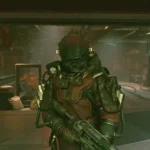Decoding the Dilemma: Should I Kill Maya Cruze Starfield?
Imagine finding yourself in a gripping moral quandary – should you eliminate the enigmatic Maya Cruze Starfield? In this thought-provoking exploration, we delve into the depths of this perplexing dilemma and attempt to unravel the complexities surrounding Maya’s fate. Brace yourself as we embark on a journey to understand the consequences and rewards that lie in the balance. But first, let’s take a closer look at the enigmatic Maya Cruze Starfield and discover the truth behind her enigmatic persona. Get ready to be captivated by a tale that will challenge your perceptions and leave you pondering the intricacies of the human condition.
Decoding the Dilemma: Should I Kill Maya Cruze Starfield?
In the immersive realm of gaming, players often confront ethical quandaries that test their principles. A particularly poignant example is the fate of Maya Cruze Starfield, a character whose life hangs in the balance. The decision to kill or spare her transcends mere gameplay; it’s a reflection of the player’s moral compass.
Understanding Maya Cruze Starfield
Maya Cruze Starfield is a fictional embodiment of suffering due to complex regional pain syndrome (CRPS), a condition shrouded in medical mystery. It casts a shadow of unrelenting pain over Maya’s existence. Her plight sheds light on the invisible battles individuals with chronic conditions face, inviting players to ponder profound ethical questions.
Consequences and Rewards
Contrary to many gaming scenarios where choices carry weighty consequences, Maya’s fate does not significantly alter the game’s landscape. The tangible benefits gleaned from her demise are trivial; the quest reaches its conclusion whether she lives or dies. This lack of game-driven incentive propels players to base their decision on a deeper ethical analysis rather than on strategic gain.
| Decision | Consequences | Quest Outcome | Rewards |
|---|---|---|---|
| Kill Maya Cruze Starfield | Minimal | Completed | Negligible |
| Spare Maya Cruze Starfield | Minimal | Completed | Intangible |
Players are thus thrust into a silent contemplation of Maya’s worth beyond the game’s mechanics. It becomes a moment of introspection, a test of one’s empathy and values. The decision is symbolic, a mirror reflecting the player’s own sense of justice and mercy.
As you stand before Maya, the option to kill her might seem like a mere press of a button. But it’s more than that. It’s a choice that questions the value of life in the face of suffering, and whether mercy killing can truly be considered merciful. The game subtly nudges you to confront these dilemmas, making the act of deciding Maya’s fate an intensely personal journey.
Ultimately, the decision resides with the player, a solitary judge in this digital court. The game watches, impassive, as you weigh the scales of moral choice. In this moment, Maya Cruze Starfield becomes more than just a character; she becomes a testament to the power of ethical decision-making in the virtual world.
As you navigate this moral maze, remember, the path you choose is a reflection of your inner narrative, one that will continue to unfold as the game progresses.
Identifying the Real Maya
The quest to determine the true identity of Maya Cruze Starfield takes players deep into the heart of ethical ambiguity. As you navigate the sterile halls of The Clinic, you are faced with a puzzling choice. Both Candace Doolin and Jane Nakamori bear striking resemblances to Maya, their medical charts echoing facets of her condition. This mirroring of details is a clever narrative ploy, designed to make you question the very nature of identity in a digital realm. How can one be certain they have found the real Maya? This question haunts your every step, urging a thorough and conscientious investigation—a true testament to the game’s commitment to immersive storytelling.
For the diligent player, the game offers a lifeline. By utilizing your Security Skill, you can peel back the layers of uncertainty. This skill, a digital sleuthing tool within your arsenal, allows you to cross-reference records, analyze biometric data, and ultimately piece together the puzzle of Maya’s true identity. It’s a task that asks you to not only engage with the game on a mechanical level but to also consider the ethical implications of your detective work. For more information on how to make the most of your Security Skills, you can visit this link.
Maya’s Personal Tragedy
Peering beyond the clinical data and into the personal life of Maya, one discovers a tapestry of sorrow intricately woven into her character. The loss of her baby, a heart-rending outcome of a rare and tragic “freak accident” in utero, adds a profound depth to her narrative. The combination of the umbilical cord’s entanglement and the ingestion of the placenta paints a somber picture of her journey, a journey already marred by the shadows of a previous stillbirth. These losses, occurring within such a brief span, lend a palpable weight to Maya’s digital existence, challenging the player’s sense of empathy and justice.
Maya’s Resilience
Yet, it is not solely within the realm of tragedy that Maya’s character is defined. The resilience she displays is nothing short of remarkable. Despite the bleakness of her past miscarriages, including the most recent one last June at a mere 10 weeks, Maya’s spirit remains unbroken. Her relentless pursuit of life, in the face of such overwhelming odds, serves as a beacon that illuminates the darker corners of the game’s narrative. It is this indomitable will to survive that makes the decision to kill or spare Maya all the more poignant. As players, we are not just choosing the fate of a character; we are weighing the value of a life marked by both immense sorrow and an inspiring will to persevere.
In this intricate weave of digital storytelling, every choice carries a weight, and every action echoes the complexities of life’s moral tapestry. The Clinic, with its labyrinth of ethical dilemmas, cements itself as more than a mere backdrop for gaming—it becomes a crucible for the examination of our deepest values.
Final Thoughts
When faced with the harrowing decision of whether to kill Maya Cruze Starfield or let her live, players find themselves at a crossroads that tests not just their in-game resolve but their philosophical beliefs. The complexity of this choice goes beyond the confines of the screen, tapping into the universal themes of redemption and humanity. As you stand before Maya, consider the layers of her persona, the echoes of her past, the moral fabric that has been intricately woven into her story. Your actions will not rewrite her history, but they will define the closing chapters of her tale.
It’s true that the tangible outcomes of this decision may seem inconsequential at first glance. The absence of significant game-changing rewards or far-reaching consequences might suggest a false sense of simplicity. However, the game’s narrative prowess lies in its ability to provoke introspection. The moral implications of your decision resonate far louder than the haptic feedback of your controller or the flicker of pixels on your screen. The question isn’t just about Maya’s fate—it’s about the weight of a virtual life and how it balances against your internal moral scales.
As you weigh your decision, you might draw parallels to the questline involving Ron Hope. The outcome of that mission offered a clear dichotomy between material gain and moral satisfaction, challenging players to prioritize their values. Unlike the black-and-white nature of that choice, Maya’s predicament exists in a grey area, devoid of clear rewards or punishments, pushing you to ponder the essence of ethical gameplay.
By choosing to spare Maya, you allow her to continue a life fraught with challenges yet also ripe with potential for growth and redemption. Conversely, deciding to end her digital existence might bring a swift and somber resolution to her saga, leaving players to reflect on the finality of their choice. This moment is a testament to the game’s profound narrative, where every decision is a mirror reflecting the player’s own ethical compass.
Before you proceed, take a moment to revisit the information on Maya’s condition to ensure that your choice is an informed one. In the end, the judgment you pass on Maya Cruze Starfield is more than just a storyline fork; it’s a virtual litmus test of your capacity for empathy and the personal codes you adhere to when the delineation between right and wrong is not distinctly drawn by the game itself.
Whatever your decision may be, it’s essential to remember that the essence of gaming—particularly in narratives as rich and complex as this one—lies in its power to engage us in profound ethical exercises. The impact of your choice on Maya will reverberate through the remaining chapters of the game, serving as a poignant reminder of the enduring influence of our actions, both virtual and real.
FAQ
Q: Why isn’t Starfield as gory as Fallout?
A: Although the exact reason is unknown, some speculate that Bethesda toned down the violence in Starfield to make it appear more family-friendly. However, it is important to note that the game still includes a significant amount of murder and violence.
Q: Why does Starfield have an M rating?
A: Starfield received a Mature 17+ rating due to several factors. These include in-game violence, blood, strong language, suggestive themes, and the presence of a fictional drug called Aurora. For more detailed information, you can visit GameWatcher[www.gamewatcher.com].
Q: Does Starfield feature a lot of violence?
A: Yes, Starfield does include a significant amount of violence. While Bethesda may have toned down the gore compared to their previous games, the presence of murder and violence is still prominent in the game.
Q: What is the fictional drug called in Starfield?
A: The fictional drug in Starfield is called Aurora. It is one of the factors contributing to the game’s Mature 17+ rating.







